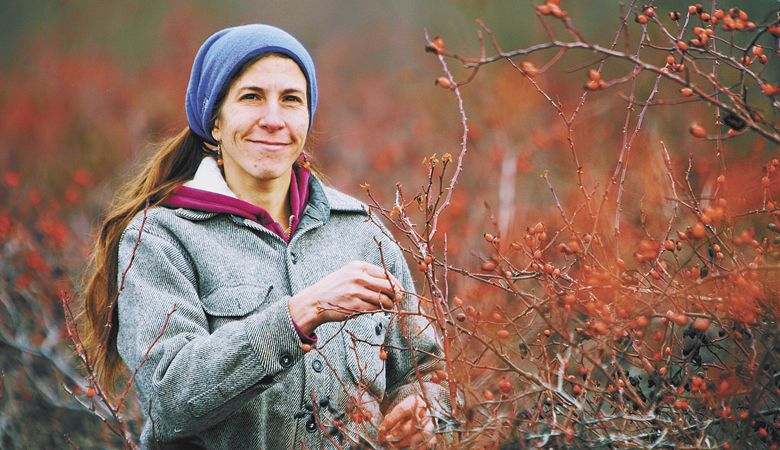Fruit Alors!
Homesteader ferments Oregon state flower
Riddle me this: When is a grape not a grape?
The answer grows on Mahonia aquifolium, an evergreen shrub better known as Oregon Tall Grape. Despite its name, the purplish fruit clusters are nothing more than berries in grape-skin clothing.
I stumbled across this conundrum at Wild Wines in the heart of Southern Oregon’s Applegate Valley, where homesteader/winemaker Carla David harvests Mahonia aquifolium’s berries to make her Oregon Grape wine. Fruit wines are her specialty.
David’s wine story begins in William, located 15 miles south of Jacksonville. That’s where David, a budding herbalist, arrived in 1999 to apprentice for a prominent herbal supplement producer.
“I was living on a property with hundreds of fruit trees. Making a value-added product out of the bounty that surrounded me seemed like a resourceful thing to do,” David said. After researching fruit wines, she borrowed equipment from a friend and made her first batch with plums, leading to a dandelion wine, followed by an elderberry version.

She was hooked.
In 2007, David released her first commercial fruit wines. Today, she makes 600 cases annually under her Wild Wines label, selling most from her tasting room. Her wines can also be purchased on her website, www.enjoywildwines.com, and in retail settings from Ashland to Portland.
I know what many of you might believe: Wines made with fruit can’t possibly be taken seriously. I call this Boone’s Farm Syndrome. If for no other reason, fruit wines deserve props for their role in Oregon’s wine history.
Wines made with everything from cherries to prunes got Oregonians in the habit of drinking wine when Prohibition ended in 1933. The success of those early fruit wines paved the way for the Vitis vinifera that followed. Fruit wines were not, however, merely a relic of the Dust Bowl era.
In the late 1960s and early ’70s, the vast majority of the state’s wines were fruit wines. People paid almost as much money in 1972 for an Oak Knoll strawberry wine as they did for grape wines made by the legendary likes of Richard Sommer or Charles Coury.
David’s 2018 Wild Wines Oregon Grape Wine, sold for $20 at the winery, clearly has history on its side.
The process for making this wine is simple. Berries are harvested and de-stemmed; leaves and other bits of debris also removed. Afterward, the berries are placed in a freezer until harvest is finished.
The deep freeze treatment is out of necessity, as fruit on the various shrubs doesn’t ripen simultaneously. David also appreciates how freezing the fruit acts like an uber-cold maceration by breaking down a berry’s cell wall before fermentation.
When she’s ready to make wine, David thaws the berries and tosses them into 55-gallon plastic fermentation barrels. Yeast, water and organic, unrefined cane sugar are the only other ingredients. That’s it. David doesn’t even add sulfites.
Fermentation lasts for approximately a month. The finished wine rests for two years before bottling. David feels the long rest rounds out any potentially sharp edges. After two months of bottle conditioning, the wine is finally released to the public.
Now, for the shocker: Wild Wines Oregon Grape Wine smells and tastes like a Fino sherry.
Scents of saline, almonds and crusty baguette filled the room as I poured the garnet-colored wine into my glass. They were joined by an earthy quality reminiscent of a clean, cool potato cellar. Buried in the background were traces of coriander and something reminding me of a Tootsie Pop’s candy shell.
My first sip revealed its bone dryness at 13% alcohol by volume. In fact, “dry as dust” is David’s house style as she proves fruit wines don’t have to be sweet. Flavors include yellow apple peels, salty green olives and some more earth. It tasted earthy, juicy and tannic all at once — I hit this bottle harder than Este Haim’s violent drum solo on “Oh Well.”
I was won over by this fruit wine, smelling and tasting like it was made with the Pedro Ximénez grape of sherry fame. In fact, this wine tastes closer to Madrid than Medford. I could easily sip it solo as an aperitif or let it cut through the fat of jamón. It also pairs nicely with roasted Marcona almonds and a chunk of Manchego or medium Cheddar cheese.
Celebrate and enjoy the fruits of Carla David’s labors. You owe it to our state flower.
The Changeup, a monthly column by Michael Alberty, is a baseball pitch designed to disorient and confuse. It’s the perfect representation of the unknown and its mastery over those who think they know what to expect. This column is devoted to those unorthodox Oregon wines you never saw coming.











